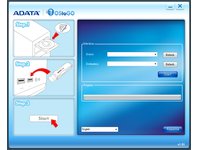USB 3.0-Based 2.5" Hard Disks From Adata, Hitachi, And WD
USB 3.0 allows external hard drives to realize their performance potential. Each of the three external USB 3.0-based 2.5” disks we're reviewing also excels in some other discipline. We study these specialties up close: speed, capacity, and durability.
Adata DashDrive Durable HD710 (750 GB)
Adata's USB 3.0-based DashDrive Durable HD710 is available in capacities of 500 GB, 750 GB, and 1 TB. You can find the external case highlighted by yellow, blue, or black, and there's no price difference between the colors. We just so happened to test a blue 750 GB model, which sells for just over $100 on Amazon. We liked that the drive's USB 3.0 cable is integrated, and thus cannot be forgotten or, worse, lost.
The DashDrive Durable HD710 is ruggedized, and Adata isn’t shy about advertising that fact. Its massive case sports diagonally-printed stripes that make us think of highway warning signs. According to its manufacturer, the HD710 conforms to the international standard IEC 529 IPX7, surviving a 30-minute immersion in 1 m (3 ft) of water. It can also survive a drop test, according to MIL-STD-810G 516.5, which is equivalent to a fall from a table to the floor.
Somewhat disappointingly for such a purportedly tough drive, its warranty runs out after a mere three years.


Robustness is what sets the Adata drive apart from the other two products in our story. It's suitable for taxing operating conditions that might render other mechanical devices unusable. Inside, Adata employs a 5400 RPM hard drive, which assures modest (but not particularly noteworthy) performance. Its sequential read and write rates of 77.8 MB/s earn the DashDrive a last-place finish amongst our three test candidates. Then again, that's not too far down the ladder. Western Digital's My Passport achieves a slightly higher result that hovers around 83 MB/s.


In contrast to its competitors, Adata's DashDrive Durable HD710 does not come with software. Its bundle is limited to a quick-start guide and the USB 3.0 cable built right into the external enclosure. Two tools, OStoGo and UFDtoGo, can be downloaded from the Adata website. But they're relatively mundane offerings: OStoGo copies the files off of a Windows 7 DVD on the external drive, and then modifies them in such a way that you can install Windows from the HD710. UFDtoGo synchronizes personal data (like email and browser favorites) between a PC and Adata's product.


Get Tom's Hardware's best news and in-depth reviews, straight to your inbox.
Current page: Adata DashDrive Durable HD710 (750 GB)
Prev Page Outside The Box: Three USB 3.0-Based Hard Drives Next Page Hitachi Touro Mobile Pro (750 GB, HTOLMNA7501BBB)-
alidan how fast is usb3? i mean real world, say you put a ssd in the best enclosure, what would it do?Reply -
thezooloomaster alidanhow fast is usb3? i mean real world, say you put a ssd in the best enclosure, what would it do?Reply
The theoretical bandwidth of USB 3.0 is roughly 625 MB/s, but this speed is rarely achieved -- even with the fastest hardware -- because the bus relies on a protocol for transferring data which is poorly optimized and eats up a chunk of the bandwidth. -
shahrooz alidanhow fast is usb3? i mean real world, say you put a ssd in the best enclosure, what would it do?I get like 70~140 MB/s (copying from WD my passport 1TB to my WD HDD (7200rpm black))Reply
and I get 30~40 MB/s copying from USB 2 WD my book 2TB to ^^^^^^^^^^^^^^^ -
willyroc shahroozI get like 70~140 MB/s (copying from WD my passport 1TB to my WD HDD (7200rpm black))and I get 30~40 MB/s copying from USB 2 WD my book 2TB to ^^^^^^^^^^^^^^^USB 3 is more than twice as fast as USB 2.Reply -
tridon I'm sitting here, daydreaming about a Velociraptor external drive. Maybe that would be able to use the USB 3's capacity better, or maybe something's slightly wrong in my head for wishing for such a thing.Reply -
ojas willyrocUSB 3 is more than twice as fast as USB 2.Yeah but you're still limited to both the source and destination drive's read/write speed. So when copying from a HDD to an HDD, you're unlikely to exceed 140 MBps.Reply
If you're copying from a SATA 3 SSD to a USB 3.0 SSD, then yes, you could see much faster speeds. -
jaquith USB 3.0 + UASP (or) eSATA (or) Internal (SATA 2 or 3) HDD.Reply
USB 3.0 in most instances isn't ready for prime time for external HDD's, and without UASP the queuing is too slow; UASP solves this problem. Otherwise without UASP IMO use eSATA or a backup internal SATA HDD.
More info see TH article June 20th, 2012 - http://www.tomshardware.com/reviews/usb-3-uas-turbo,3215.html
Note: The Hitachi Touro fails (BSOD) in Windows 8. -
ubercake So... Theoretically USB 3.0 is faster than eSata, but in practice eSata is still the way to go?Reply -
LukeCWM ubercakeSo... Theoretically USB 3.0 is faster than eSata, but in practice eSata is still the way to go?Yes.Reply -
alidan shahroozI get like 70~140 MB/s (copying from WD my passport 1TB to my WD HDD (7200rpm black))and I get 30~40 MB/s copying from USB 2 WD my book 2TB to ^^^^^^^^^^^^^^^Reply
that 1tb is in a better case than the 2tb
what i have noticed with usb 3 is that, yes while its theoretical max is higher than current hdd and ssds should achieve, the fact of the matter is they never hit that peak.
thats why im wondering, with an ssd, what is the best we can get usb3 to.
you proved that current normal hdds in a good case do not have a problem in usb 3, and for that i thank you.
